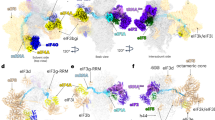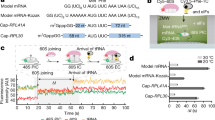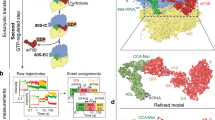Abstract
Unlike bacteria, a specialized eukaryotic initiation factor (eIF)-2, in the form of the ternary complex eIF2–GTP–Met-tRNAi Met, is used to deliver the initiator tRNA to the ribosome in all eukaryotic cells. Here we show that the hepatitis C virus (HCV) internal ribosome entry site (IRES) can direct translation without eIF2 and its GTPase-activating protein eIF5. In addition to the general eIF2- and eIF5-dependent pathway of 80S complex assembly, the HCV IRES makes use of a bacterial-like pathway requiring as initiation factors only eIF5B (an analog of bacterial IF2) and eIF3. The switch from the conventional eukaryotic mode of translation initiation to the eIF2-independent mechanism occurs when eIF2 is inactivated by phosphorylation under stress conditions.
This is a preview of subscription content, access via your institution
Access options
Subscribe to this journal
Receive 12 print issues and online access
$189.00 per year
only $15.75 per issue
Buy this article
- Purchase on Springer Link
- Instant access to full article PDF
Prices may be subject to local taxes which are calculated during checkout





Similar content being viewed by others
References
Gualerzi, C.O. et al. Initiation factors in the early events of mRNA translation in bacteria. Cold Spring Harb. Symp. Quant. Biol. 66, 363–376 (2001).
Allen, G.S. & Frank, J. Structural insights on the translation initiation complex: ghosts of a universal initiation complex. Mol. Microbiol. 63, 941–950 (2007).
Hershey, J.B.W. & Merrick, W.C. The Pathway and Mechanism of Initiation of Protein Synthesis. in Translational Control of Gene Expression (eds. Sonenberg, N., Hershey, J. & Merrick, W.C.) 33–88 (Cold Spring Harbor Laboratory Press, Cold Spring Harbor, New York, 2000).
Ron, D. & Harding, H.P. eIF2α Phosphorylation in Cellular Stress Responses and Disease. in Translational Control in Biology and Medicine (eds. Mathews, M.B., Sonenberg, N. & Hershey, J.W.B.) 345–368 (Cold Spring Harbor Laboratory Press, Cold Spring Harbor, New York, 2006).
Belsham, G.J. & Jackson, R.J. Translation Initiation on Picornavirus RNA. in Translational Control (eds. Sonenberg, N., Hershey, J.B.W. & Mathews, M.B.) 869–900 (Cold Spring Harbor Laboratory Press, Cold Spring Harbor, New York, 2000).
Pestova, T.V., Shatsky, I.N., Fletcher, S.P., Jackson, R.J. & Hellen, C.U. A prokaryotic-like mode of cytoplasmic eukaryotic ribosome binding to the initiation codon during internal translation initiation of hepatitis C and classical swine fever virus RNAs. Genes Dev. 12, 67–83 (1998).
Pisarev, A.V. et al. Functional and structural similarities between the internal ribosome entry sites of hepatitis C virus and porcine teschovirus, a picornavirus. J. Virol. 78, 4487–4497 (2004).
Choi, S.K., Lee, J.H., Zoll, W.L., Merrick, W.C. & Dever, T.E. Promotion of Met-tRNAi Met binding to ribosomes by yIF2, a bacterial IF2 homolog in yeast. Science 280, 1757–1760 (1998).
Pestova, T.V., Lorsch, J.R. & Hellen, C.U.T. The Mechanism of Translation Initiation in Eukaryotes. in Translational Control in Biology and Medicine (eds. Mathews, M.B., Sonenberg, N. & Hershey, J.B.W.) 87–128 (Cold Spring Harbor Laboratory Press, Cold Spring Harbor, New York, 2007).
Locker, N., Easton, L.E. & Lukavsky, P.J. HCV and CSFV IRES domain II mediate eIF2 release during 80S ribosome assembly. EMBO J. 26, 795–805 (2007).
Pestova, T.V. et al. The joining of ribosomal subunits in eukaryotes requires eIF5B. Nature 403, 332–335 (2000).
Peterson, D.T., Merrick, W.C. & Safer, B. Binding and release of radiolabeled eukaryotic initiation factors 2 and 3 during 80 S initiation complex formation. J. Biol. Chem. 254, 2509–2516 (1979).
Peterson, D.T., Safer, B. & Merrick, W.C. Role of eukaryotic initiation factor 5 in the formation of 80 S initiation complexes. J. Biol. Chem. 254, 7730–7735 (1979).
Roll-Mecak, A., Cao, C., Dever, T.E. & Burley, S.K. X-Ray structures of the universal translation initiation factor IF2/eIF5B: conformational changes on GDP and GTP binding. Cell 103, 781–792 (2000).
Lancaster, A.M., Jan, E. & Sarnow, P. Initiation factor-independent translation mediated by the hepatitis C virus internal ribosome entry site. RNA 12, 894–902 (2006).
Andreev, D.E., Terenin, I.M., Dunaevsky, Y.E., Dmitriev, S.E. & Shatsky, I.N. A leaderless mRNA can bind to mammalian 80S ribosomes and direct polypeptide synthesis in the absence of translation initiation factors. Mol. Cell. Biol. 26, 3164–3169 (2006).
Costa-Mattioli, M., Svitkin, Y. & Sonenberg, N. La autoantigen is necessary for optimal function of the poliovirus and hepatitis C virus internal ribosome entry site in vivo and in vitro. Mol. Cell. Biol. 24, 6861–6870 (2004).
Otto, G.A. & Puglisi, J.D. The pathway of HCV IRES-mediated translation initiation. Cell 119, 369–380 (2004).
Farrell, P.J., Balkow, K., Hunt, T., Jackson, R.J. & Trachsel, H. Phosphorylation of initiation factor elF-2 and the control of reticulocyte protein synthesis. Cell 11, 187–200 (1977).
Harding, H.P., Zhang, Y., Bertolotti, A., Zeng, H. & Ron, D. Perk is essential for translational regulation and cell survival during the unfolded protein response. Mol. Cell 5, 897–904 (2000).
McEwen, E. et al. Heme-regulated inhibitor kinase-mediated phosphorylation of eukaryotic translation initiation factor 2 inhibits translation, induces stress granule formation, and mediates survival upon arsenite exposure. J. Biol. Chem. 280, 16925–16933 (2005).
Brush, M.H., Weiser, D.C. & Shenolikar, S. Growth arrest and DNA damage-inducible protein GADD34 targets protein phosphatase 1 α to the endoplasmic reticulum and promotes dephosphorylation of the α subunit of eukaryotic translation initiation factor 2. Mol. Cell. Biol. 23, 1292–1303 (2003).
Honda, M. et al. Cell cycle regulation of hepatitis C virus internal ribosomal entry site-directed translation. Gastroenterology 118, 152–162 (2000).
Rivas-Estilla, A.M. et al. PKR-dependent mechanisms of gene expression from a subgenomic hepatitis C virus clone. J. Virol. 76, 10637–10653 (2002).
Robert, F. et al. Initiation of protein synthesis by hepatitis C virus is refractory to reduced eIF2·GTP·Met-tRNAiMet ternary complex availability. Mol. Biol. Cell 17, 4632–4644 (2006).
Nishiyama, T. et al. Structural elements in the internal ribosome entry site of Plautia stali intestine virus responsible for binding with ribosomes. Nucleic Acids Res. 31, 2434–2442 (2003).
Jan, E. & Sarnow, P. Factorless ribosome assembly on the internal ribosome entry site of cricket paralysis virus. J. Mol. Biol. 324, 889–902 (2002).
Garber, K. Hepatitis C: staying the course. Nat. Biotechnol. 25, 1379–1381 (2007).
Bakhshesh, M. et al. The picornavirus avian encephalomyelitis virus possesses a hepatitis C virus-like internal ribosome entry site element. J. Virol. 82, 1993–2003 (2008).
Kaminski, A., Belsham, G.J. & Jackson, R.J. Translation of encephalomyocarditis virus RNA: parameters influencing the selection of the internal initiation site. EMBO J. 13, 1673–1681 (1994).
Pestova, T.V., Hellen, C.U. & Shatsky, I.N. Canonical eukaryotic initiation factors determine initiation of translation by internal ribosomal entry. Mol. Cell. Biol. 16, 6859–6869 (1996).
Reynolds, J.E. et al. Internal initiation of translation of hepatitis C virus RNA: the ribosome entry site is at the authentic initiation codon. RNA 2, 867–878 (1996).
Reynolds, J.E. et al. Unique features of internal initiation of hepatitis C virus RNA translation. EMBO J. 14, 6010–6020 (1995).
Merrick, W.C. & Anderson, W.F. Purification and characterization of homogeneous protein synthesis initiation factor M1 from rabbit reticulocytes. J. Biol. Chem. 250, 1197–1206 (1975).
Choi, S.K. et al. Physical and functional interaction between the eukaryotic orthologs of prokaryotic translation initiation factors IF1 and IF2. Mol. Cell. Biol. 20, 7183–7191 (2000).
Dmitriev, S.E., Pisarev, A.V., Rubtsova, M.P., Dunaevsky, Y.E. & Shatsky, I.N. Conversion of 48S translation preinitiation complexes into 80S initiation complexes as revealed by toeprinting. FEBS Lett. 533, 99–104 (2003).
Terenin, I.M. et al. A cross-kingdom internal ribosome entry site reveals a simplified mode of internal ribosome entry. Mol. Cell. Biol. 25, 7879–7888 (2005).
Dmitriev, S.E. et al. Efficient translation initiation directed by the 900-nucleotide-long and GC-rich 5′ untranslated region of the human retrotransposon LINE-1 mRNA is strictly cap dependent rather than internal ribosome entry site mediated. Mol. Cell. Biol. 27, 4685–4697 (2007).
Acknowledgements
We thank L.P. Ovchinnikov (Institute of Protein Research, Pushchino, Russia) for the kind gift of eEF2 and W.C. Merrick (Case Western Reserve University, Cleveland, USA) for anti-eIF2α antibodies. We appreciate the advice from P. Lukavsky on eIF5B expression. We are also grateful to G. Belsham, A. Hinnebusch and N. Sonenberg for critical reading of the manuscript and valuable suggestions. This work was supported by grants 07-04-01222 and 05-04-49704 from the Russian Foundation for Basic Research (RFBR) to I.M.T. and I.N.S., respectively.
Author information
Authors and Affiliations
Contributions
I.M.T. and S.E.D. contributed equally to this work. I.M.T. and D.E.A. performed in vitro experiments; S.E.D. carried out cell transfection studies; and I.N.S., S.E.D. and I.M.T. wrote the article. All authors discussed the results and commented on the manuscript.
Corresponding author
Rights and permissions
About this article
Cite this article
Terenin, I., Dmitriev, S., Andreev, D. et al. Eukaryotic translation initiation machinery can operate in a bacterial-like mode without eIF2. Nat Struct Mol Biol 15, 836–841 (2008). https://doi.org/10.1038/nsmb.1445
Received:
Accepted:
Published:
Issue Date:
DOI: https://doi.org/10.1038/nsmb.1445
This article is cited by
-
Maternal immune activation in mice disrupts proteostasis in the fetal brain
Nature Neuroscience (2021)
-
Depletion of eukaryotic initiation factor 5B (eIF5B) reprograms the cellular transcriptome and leads to activation of endoplasmic reticulum (ER) stress and c-Jun N-terminal kinase (JNK)
Cell Stress and Chaperones (2021)
-
The role of host eIF2α in viral infection
Virology Journal (2020)
-
Viral RNA structure-based strategies to manipulate translation
Nature Reviews Microbiology (2019)
-
Eukaryotic initiation factor 5B (eIF5B) provides a critical cell survival switch to glioblastoma cells via regulation of apoptosis
Cell Death & Disease (2019)



